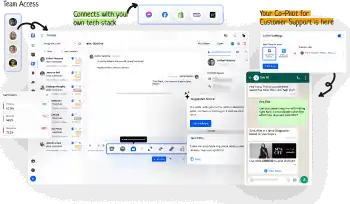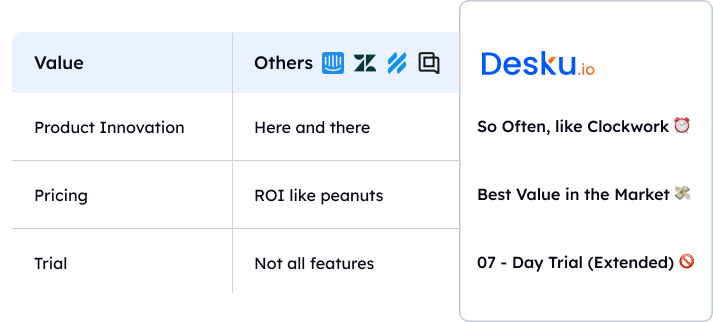Think of yourself as a hero, not slaying mythical beasts, but dealing with customer concerns and inquiries. Your tool in this modern battlefield is Time to Resolution or TTR.
TTR is an important indicator of how efficiently your customer service operates, showing how quickly you can sort out customer issues. The quicker you can resolve these problems, the happier your customers will be.
But what’s the method to calculate TTR, and more importantly, what can you do to lower it?
Stay with us, as we’re about to share some insights that could completely overhaul your customer service approach.
Time to Resolution (TTR) in customer support refers to the duration it takes to resolve a customer’s issue from the moment it’s reported to the time it’s fully resolved. A lower TTR indicates efficient customer service operations, leading to higher customer satisfaction.
Key Takeaway :
Measuring TTR is crucial because it directly impacts customer satisfaction and loyalty. Quick resolution times show customers that a business values their time and is committed to solving their problems efficiently. Additionally, monitoring TTR helps identify any recurring issues or bottlenecks in the support process, allowing for continuous improvement in service quality and operational efficiency.
What is the Time to Resolution?
Time to resolution is the amount of time it takes to fix a problem after it’s been reported. It is quick and efficient for your support team when it comes to sorting our customer issues.
In customer service, we often talk about Time to Resolution (TTR). But let’s break it down – what does it mean?
💡Think of it this way – if your team is super quick at fixing problems, your TTR will be lower. And let’s be honest, no one likes to wait, especially not your customers. So, a lower TTR is a sign of a smooth-running team and happy customers. It’s a win-win!
But there’s more. TTR isn’t just about speedy resolutions. It’s also a marker of how dedicated your company is to resolving customer issues promptly. Let’s not forget – that a company that values its customers’ time is a company that earns customer loyalty.
Keeping an eye on your TTR can also help you spot any issues that might’ve slipped through the cracks or are taking a bit longer to resolve than they should. This can be super useful when it comes to handling more complex cases or identifying any processes that seem to be slowing things down.
By being aware of these issues, you can take steps to improve your TTR, which in turn can boost customer satisfaction and loyalty. Because at the end of the day, a happy customer is a loyal customer.
Why do you need to measure Time to Resolution?
Selling and making money in a business is important but most business owners forget about the time taken by the business to resolve the queries of the customers.
But why it is important? Why do business owners need to take care for time to resolve? Let’s know it.
- Makes Customers Happy: Imagine you have a toy that breaks. If it gets fixed super fast, you’re going to be happy, right? That’s how customers feel when their problems are solved quickly.
- Shows You Care: Quick fixes show customers you care about their problems. It’s like giving them a high-five and saying, “We’ve got your back!”
- Keeps Customers Around: When you solve problems fast, customers are less likely to go to another store for the same toy. They remember who helped them quickly!
- Finds What Needs Fixing: Paying attention to how long it takes to fix things can show you what parts of your store need a little extra help. Maybe it’s time to teach your team something new or use a magic wand (aka technology) to make things faster.
- Aims for the Best Service: It’s all about making your store the best it can be. When you fix problems fast, it’s like making sure every toy on the shelf is ready to bring joy as soon as possible!
7 Ways To Reduce Time To Resolution
Start by making things easier for new customers with a friendly onboarding guide. It’s like giving them a map to avoid getting lost. Automate your messages to send the right note at the right time, like a personal assistant for each customer.
For the DIY fans, beef up your knowledge base with all the answers they might need. Chatbots can also jump in to help any time of the day, handling common questions on their own. And don’t forget to keep your ear to the ground with trigger surveys to understand what your customers want and need. It’s all about making things smoother and faster for everyone.
✅ Offer onboarding guidance for new users
An effective way to shorten the time it takes to solve problems is by helping new users get settled in. This not only makes the customer’s experience better, but it also helps your customer service team work more effectively.
Here are three methods you could use to help new users get started:
- Tailored Onboarding: Design resources like tutorials and guides that are personalized for each user. This can help them get to grips with your platform quickly, which in turn can reduce the time it takes to resolve any issues.
- Setup Automation: Make the initial setup process smoother by using automated onboarding workflows. This can help to reduce the number of potential problems.
- One-on-One Support: Have onboarding experts on hand to offer individual help to new users. This can make users feel more confident and supported right from the start.
✅ Use segmentation for automating in-app messages
Hey there! Let’s make your in-app messaging a breeze by using segmentation. What’s segmentation, you ask? Well, imagine being able to group your users based on their actions. Think along the lines of frequent users, newcomers, or those who’ve been a bit quiet recently.
By doing this, you can tailor your messages to each group. It’s like having a personal chat with each user, making their experience feel unique and valued. Not only does this make your interactions more personal, but it also helps reduce the time taken to resolve any issues.
Sounds great, right? But wait, there’s more! It can also save you heaps of time manually customizing each message. This means you can focus on what matters – providing top-quality customer service.
And the best part? As you start to get the hang of tracking your time to resolution, you might just see it decreasing. This means happier customers and increased user engagement. It’s a win-win!
✅ Build a knowledge base to offer customers self-service
Building a strong knowledge base for customer self-service can be a game changer in handling customer queries. Not only can it cut down on the time it takes to resolve issues, it can also boost the satisfaction of your customers. So, how can you make this a reality?
Step one, set up a broad and detailed Help Center. Having a go-to place for customers to find solutions to their issues can really make a difference. It means they can sort things out on their own, reducing their need to contact support agents, which in turn speeds up resolution times.
Secondly, consider using a Digital Adoption Platform (DAP), like Whatfix for instance. These are tools that can provide guidance within the app, incorporate FAQs, and assist in tracking the time it takes to resolve issues.
Lastly, don’t forget to keep an eye on performance. By watching trends in resolution times, you can pinpoint areas that need a little tweaking and perfect your processes.
✅ Use AI chatbot to address common customer issues
Imagine having a tool that can respond instantly and accurately to customer inquiries. Think about a tool capable of understanding the customer’s issues in a jiffy and addressing them efficiently. Well, that’s what chatbots do! They have a knack for dealing with basic problems, and if things get a little too tricky, they know when to step aside and let human agents take over.
How do they do that? Well, it’s simple. They start by collecting initial details and context from customers. This makes the support process smoother and faster. To top it all off, linking your chatbot with a knowledge base and FAQs can make it a goldmine of accurate and relevant information for customers. This speeds up the whole process of resolving issues.
✅ Trigger surveys to understand customer expectations
Understanding what your customers want is key to cutting down on resolution time. Trigger surveys can be a handy tool to accomplish this. They let you collect real-time info about how satisfied your customers are and the total time it takes to resolve issues.
Here’s how trigger surveys can help you:
- They give you a peek into what your customers want when it comes to resolving issues, making it easier to meet their needs.
- They point out recurring problems, allowing you to make your resolution process more efficient.
- They monitor shifts in customer expectations over time, helping you tweak your strategies as needed.
✅ Enable passive surveys for instant feedback submission
Do you know what can make your customer service process more efficient? Passive surveys! They’re a game-changer, honestly. Think about it. You get instant feedback from your customers, right when you need it. No more waiting around. You can dive straight into what’s bugging your customers and fix it in no time.
This is the real deal when it comes to reducing the time to resolution. That’s basically how long it takes from when your customer first reaches out with a problem, to when it gets solved. The quicker, the better, right?
And here’s the best part. Passive surveys make it super easy for your customers to let you know what they think. Just like that, they can share their feedback and you can jump into action. So, why not give it a shot? It’s a simple yet powerful way to improve your customer service quality. Trust me, your customers will thank you for it!
✅ Analyze feature usage and offer proactive help
Want to reduce your Time to Resolution? Try getting a closer look at how your product’s features are being used and be ready to lend a hand when customers seem to be having a tough time. By closely examining feature usage, pinpointing trouble spots, and extending help to customers before they even ask for it, you’ll be putting a stop to potential problems before they can fully develop.
Here’s a simple three-step process to help you out:
- Keep an Eye on User Behavior: Pay attention to how customers interact with your product. Are there any patterns? Do they seem to be stuck at certain points?
- Step in Early: You don’t have to wait for customers to ask for help. If you see them struggling in areas you’ve identified as tricky, why not step in and offer assistance?
- Stay Updated: Keep reviewing and updating your support based on feedback and changes in the way your product is being used.
Following these steps can help you decrease your time to resolution and, as a result, make your customers happier.
How to Calculate Time to Resolution?
Figuring out the Time to Resolution isn’t rocket science, trust me. You just need to keep track of when you start and finish dealing with each customer’s concerns. The average of these times will give you the average resolution time.
Let’s break it down a bit.
👉🏻You start by taking note of when you first learn about or acknowledge a customer’s issue.
👉🏻That’s your starting point. Then, you jot down when you’ve completely sorted out the problem.
👉🏻That’s your finish line. The time you spend from start to finish is what we call the resolution time.
Why is Time to Resolution critical to the CX metric?
No doubt about it, how quickly you respond to and resolve customer issues is a key part of your customer experience metrics. This is often measured by Time to Resolution (TTR), which is simply how long it takes from when a customer reports a problem to when it’s fixed.
So why is TTR so important for your CX metric? Here are three reasons:
- Keeping Customers Happy: When you resolve issues quickly, you keep customers happy. It’s as simple as that. Your TTR is directly tied to customer satisfaction – the quicker you resolve things, the happier your customers are. This leads to a better reputation for your company.
- Improving Your Service: TTR is a great tool for spotting where things might be slowing down in your customer support process. By keeping an eye on your TTR, you can spot these bottlenecks and work out how to fix them. This won’t only speed up your resolution time, but it’ll also make your operation more efficient.
- Building Customer Loyalty: A speedy TTR can also help you build a loyal customer base. When customers see that you take their issues seriously and fix them promptly, they’re more likely to stay with your service.
Benefits of Measuring Time to Resolution
Time to resolution tells a lot about your business, especially when it comes to providing the customer experience, it is much more important than providing your service. Customers should always feel seen and important.
Let’s dig in what are the benefits of measuring time to resolution in a business!
- Secret Performance Window: It’s like a magic mirror showing how awesome your customer service team is doing. When a customer says “Help!” the clock starts, and how fast you fix it can show you where to sprinkle a little improvement dust.
- Process Tune-up: Not just for show – keeping an eye on resolution time helps you tweak and polish your workflow until it shines.
- Customer Happiness Boost: Quick fixes = happy customers. It’s a simple math that adds up to loyal fans and a sparkling brand image.
- Team Supercharge: Spotting slow spots helps your team zip through tasks faster, turning them into productivity superheroes.
- Stickiness for Customers: Fast solutions mean customers stick around like glue. Lower resolution time might just be the secret ingredient to keeping your customer base happy and growing.
Time to Resolution benchmarks
You know, it’s really important to set some benchmarks for how quickly your support team can resolve issues.
Think about what your customers might expect in terms of timing.
Consider what’s involved in solving their problems, and how quickly your rivals might handle similar issues.
This will help you set some realistic and competitive targets for your team to aim for.
What time frame does your customer expect?
Understanding what your customer expects in terms of issue resolution time is incredibly important. Here are a few things you should keep in mind:
- Benchmarks for Issue Resolution: These are standards that help you measure the performance of your customer service team, especially how fast they can resolve issues. A great team will have lower benchmarks, showing they respect their customers’ time.
- Variation in Resolution Time: Don’t forget that the time it takes to resolve an issue can change based on how complex the issue is. It’s a good idea to let your customers know this so they have a realistic expectation of how long it might take.
- Reducing Resolution Time: There are several strategies you can use to decrease the timeframe for resolving customer issues. For instance, you can work on improving how your team communicates, making your processes more efficient, and providing your team with the necessary training. These can all help to resolve customer issues faster.
Conclusion: Time to Resolution is an important factor for Customer Experience
Desku streamlines customer support processes, significantly reducing time to resolution and accelerating query resolution. By leveraging AI-driven automation and a unified inbox, it organizes customer queries efficiently, allowing support teams to respond promptly.
Its AI Team Assist and conversational AI features understand and categorize inquiries, suggesting instant, intelligent responses. This automation minimizes manual workload, enabling support agents to focus on complex issues.
Additionally, Desku’s knowledge base empowers customers with self-service options, reducing the volume of incoming queries. With these integrated tools, Desku ensures a swift, effective support experience, enhancing customer satisfaction and operational productivity.
Frequently Asked Questions
What is Time to Resolution (TTR) in Customer Support?
Time to Resolution (TTR) refers to the duration it takes to resolve a customer’s issue from the moment it’s reported to the time it’s fully resolved. A lower TTR indicates efficient customer service operations, leading to higher customer satisfaction. It measures the effectiveness of a support team in addressing and solving customer problems promptly.
Why is Measuring Time to Resolution Important?
Measuring TTR is crucial because it directly impacts customer satisfaction and loyalty. Quick resolution times show customers that a business values their time and is committed to solving their problems efficiently. Additionally, monitoring TTR helps identify any recurring issues or bottlenecks in the support process, allowing for continuous improvement in service quality and operational efficiency.
How Can Businesses Reduce Their Time to Resolution?
businesses can reduce their TTR by implementing several strategies, including:
Offering onboarding guidance to help new users familiarize themselves with services or products, reducing initial support queries.
Automating in-app messages through segmentation to provide timely and relevant support.
Building a comprehensive knowledge base that enables customers to find answers themselves, decreasing direct support requests.
Utilizing AI chatbots to address common issues instantly without human intervention.
Conducting trigger surveys to understand customer expectations and improve service proactively.













